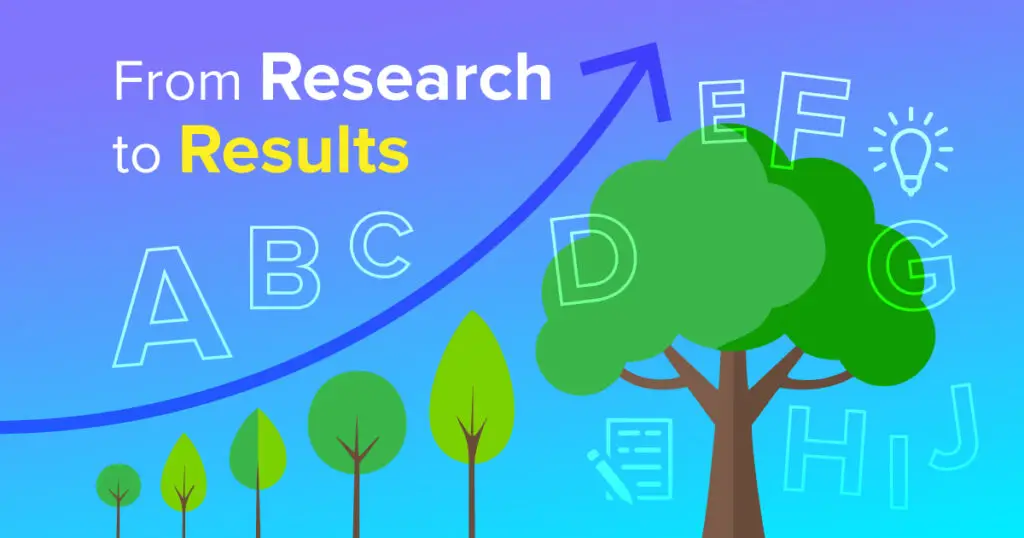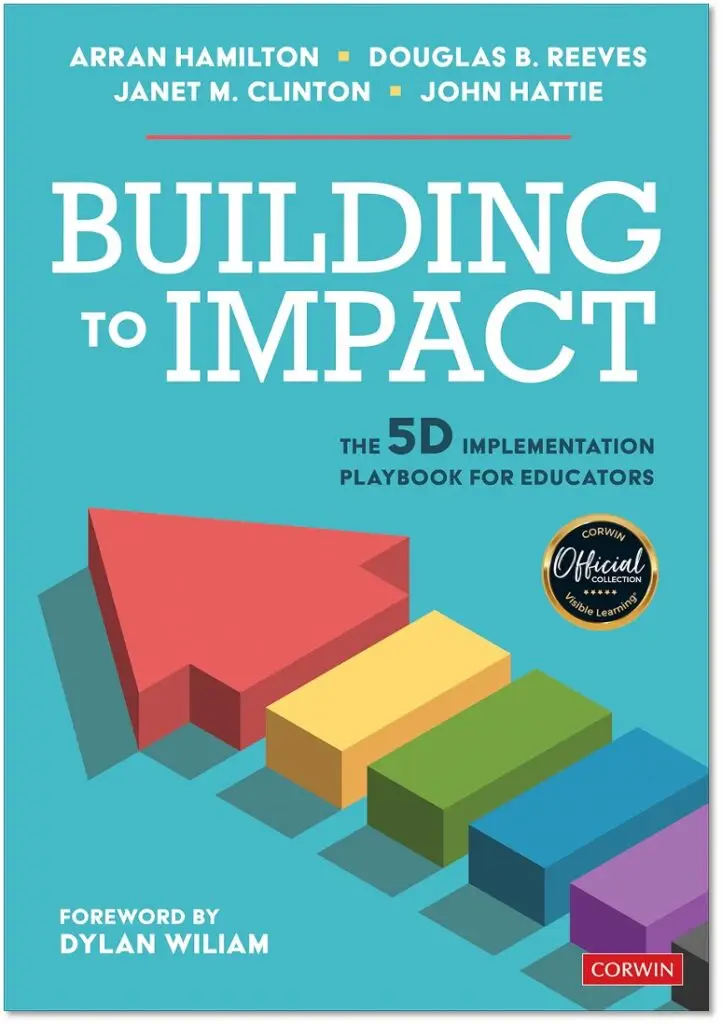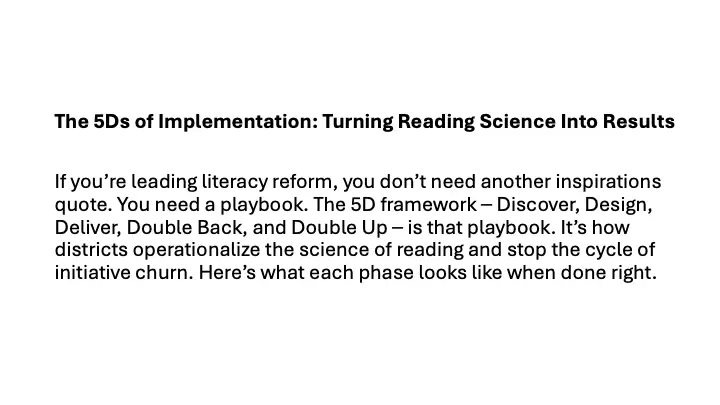
Sarah DeCotis
National Literacy Director
Too many districts have embraced the science of reading in theory but failed to deliver results in practice. This blog lays out why research alone isn’t enough—and how proven implementation methodology, like the 5D Framework, is the missing link between knowing what works and actually changing reading outcomes for kids. It’s the difference between letting something happen vs. making something happen.
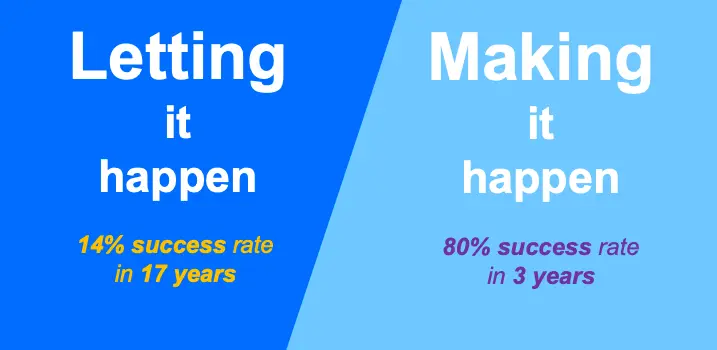
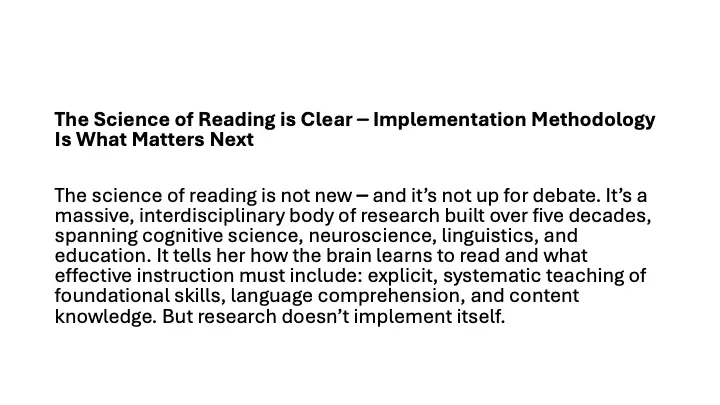
Dean Fixsen and Karen Blase, Active Implementation Practice and Science, National Implementation Research Network (NIRN).
Knowing what works isn’t the same as making it happen in real classrooms, at scale, across a system. That’s where implementation methodology comes in. One proven example is the 5D Implementation Framework—Discover, Design, Deliver, Double Back, Double Up—developed by Dr. Aarran Hamilton, Dr. Douglas Reeves, Dr. Janet Clinton, and Dr. John Hattie. Their framework provides a pragmatic, step-by-step approach to translating evidence into impact. Without a method like this, even the best intentions collapse under the weight of fragmented systems and initiative fatigue.
A. Hamilton, D.B. Reeves, J.M. Clinton and J. Hattie, Building to Impact: The 5D Implementation Playbook for Educators, First Edition, Corwin, 2022.
This is your reality check. It’s not about “raising scores”—it’s about identifying why students aren’t reading and which system-level barriers are holding them back.
- What’s your current state of Tier 1 instruction?
- Are your materials aligned to the science of reading?
- Are your teachers trained in the components of effective reading instruction?
- What does your data say about who is being served—and who’s not?
Real leaders don’t jump to solutions. They interrogate the problem until it’s impossible to ignore.
D2: Design — Build the Blueprint for Change
Now you take what you’ve learned and build a real plan. Not a binder. A system-wide approach that aligns curriculum, professional learning, coaching, scheduling, and assessment.
- Adopt HQIM aligned to the science of reading.
- Redesign the school day to protect time for foundational skills and intervention.
- Plan training that’s ongoing and supported with coaching.
- Cut the noise—eliminate resources that aren’t aligned.
This is where many districts go wrong. They “bolt on” new programs without tearing down the old ones. That’s not design. That’s clutter.
D3: Deliver — Put the Plan in Motion, Relentlessly
This is go-time. Materials are in classrooms. PD is happening. Leaders are walking classrooms. Feedback is flowing. Systems for accountability are clear.
- Every school gets what they need: training, coaching, clarity.
- Every teacher knows the plan—and their part in it.
- Every principal is held accountable for implementation, not just test scores.
If you’re not tracking fidelity during this phase, you’re guessing. And guessing is expensive.
D4: Double Back — Monitor Progress and Course-Correct
Implementation without reflection is a waste. This phase is about looking at the data and asking, “Is it working?” Not just in aggregate—but at the school, classroom, and student levels.
- Identify schools that are getting results—and why.
- Pinpoint breakdowns: Is it materials? Training? Leadership turnover?
- Adjust with precision, not panic.
This isn’t a “wait until the end of the year” moment. It’s real-time, continuous improvement. You don’t want lag data—information that arrives after the fact, when it’s too late to act. You want lead data—ongoing indicators that tell you in the moment whether implementation is on track. This is not the time for an autopsy approach, where you wait until the end of the year (or until the licenses expire) to figure out if what you bought actually worked. You want regular checkups—systematic, in-the-moment evaluations that let you make mid-course corrections before learning loss sets in.
You don’t want lag data—you want lead data
D5: Double Up — Scale What Works, Sustain the Gains
Now you amplify success. What started as a pilot or district-wide shift gets codified. You build capacity, refine systems, and protect what’s working.
- Embed PD into onboarding and PLC structures.
- Turn high-implementation schools into demonstration sites.
- Keep leadership aligned and pressure-tested for sustainability.
This is how you make change stick—and how literacy success becomes a defining part of your district’s DNA.
The Bottom Line
We’ve never had more clarity on what works to teach reading. The problem isn’t the science—it’s the system. If you’re a district leader, the ball is in your court. Get aligned. Get organized. Stop waiting for the perfect conditions. Reading failure is preventable—but only if we stop admiring the problem and start acting on the solution.
At Age of Learning, we don’t just understand the science of reading—we mobilize it. We partner with districts that are serious about making the shift from intention to implementation. Our team works shoulder-to-shoulder with educators, providing programs that are explicitly aligned to reading science and built to support real classroom practice. We’re committed to helping districts not just adopt the research, but bring it to life—for every teacher, in every school, for every student. The research is solid. The tools are ready. Let’s get to work.
To learn more about how our Age of Learning’s reading solution aligns to the Science of Reading, read our whitepaper!
For more from Sarah, click here.

